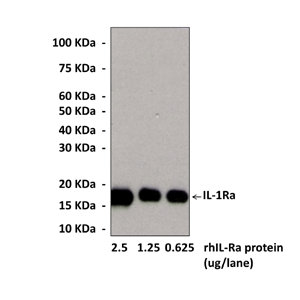Anti-IL-1Ra: Monoclonal IL-1 Receptor Antagonist Antibody |
 |
BACKGROUND The IL-1 family of cytokines is produced by activated monocytes/macrophages during the acute phase of inflammatory response. The IL-1 cytokines are also produced by a variety of other cells including neutrophiles, keratinocytes, epithelial cells, fibroblasts, adrenal cortical and medullary cells.1 The cytokine IL-1 and IL-1 have a 25% homology in amino acids. The biological action of IL-1 cytokines is the results of their binding to the IL-1 receptor type I (Rt1). A second IL-1 receptor (Rt2) does not produce any biological effect and most probably represents a “decoy receptor”. A third member of IL-1 family of cytokines is IL-1 receptor antagonist (IL-1 Ra), which exhibits same binding affinity to both types of IL-1 receptors, but without inducing a biological response, thus antagonizing the effects of IL-1.2 Interestingly, the action of IL-1 Ra is not restricted to the counterregulation of inflammatory processes. IL-1 Ra has been shown to be upregulated in the serum of obese subjects.3
REFERENCES
1. Carter, D. B. et al: Nature. 344:633, 1990.
2. Granowitz, E. V. et al: J. Biol. Chem. 266:14147, 1991.
3. Saltevo, J. et al: Diab Vasc Dis Res. 4:328, 2007.
2. Granowitz, E. V. et al: J. Biol. Chem. 266:14147, 1991.
3. Saltevo, J. et al: Diab Vasc Dis Res. 4:328, 2007.
Products are for research use only. They are not intended for human, animal, or diagnostic applications.
Параметры
Cat.No.: | CB19846 |
Antigen: | E. coli-expressed recombinant human IL-1Ra protein. |
Isotype: | Mouse IgG1 |
Species & predicted species cross- reactivity ( ): | Human |
Applications & Suggested starting dilutions:* | WB 1:1000 IP n/d IHC (paraffin) n/d ICC n/d FACS n/d |
Predicted Molecular Weight of protein: | 17 kDa |
Specificity/Sensitivity: | Detects human IL-Ra proteins. Does not cross-react with other IL-1 family members. |
Storage: | Store at -20°C, 4°C for frequent use. Avoid repeated freeze-thaw cycles. |
*Optimal working dilutions must be determined by end user.
Документы
Информация представлена исключительно в ознакомительных целях и ни при каких условиях не является публичной офертой








